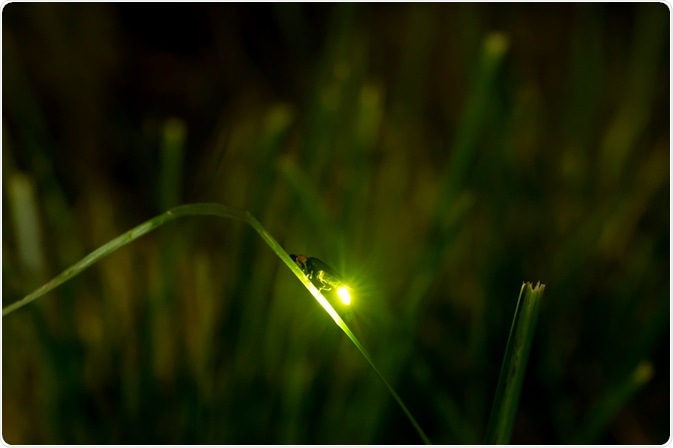Bioluminescence is an emission of light produced when the enzyme luciferase catalyzes oxidation of its substrate, luciferin.

Credit: anko70/Shutterstock.com
The most well-known instance of bioluminescence is the light produced by fireflies. Firefly luciferase has been harnessed for biological research by coupling the luciferase reaction with other enzymatic assays.
Some efforts have been made to use bioluminescence in living animals, but the firefly luciferin substrate, D-luciferin, has low tissue permeability, and poor affinity for luciferase. It also does not cross the blood-brain barrier, which limits applicability to studies of the brain.
Synthetic alternatives to the firefly luciferase system have been developed to overcome the limitations of this assay.
Luciferin analogs
A synthetic analog of D-luciferin, called AkaLumine, produces light in the near-infrared range, at 677 nm. This wavelength can penetrate the bodies and tissues of most animals. Additionally, AkaLumine distributes well to body tissues and deep organs, unlike D-luciferin.
Researchers created a synthetic bioluminescence system based on AkaLumine by modifying the luciferase gene through directed evolution. This allowed them to engineer a synthetic bioluminescence system that could be used in living animal tissues.
The resulting system produced a bioluminescence signal 1000 times stronger than firefly luciferase in mouse brain. It was also shown to allow researchers to view individual glowing cells in mouse lung.
Another alternative to D-luciferin is CyclLuc1. CycLuc1 is an aminoluciferin that has a fused five-membered indoline ring. This molecule has properties superior to D-luciferin in vivo, which means less substrate is required for imaging, and a more intense and persistent light output is produced.
CycLuc1 readily crosses the blood-brain barrier and can be used to access deep brain tissues. A redshift of emitted photons is believed to contribute to the improved intensity of light produced by CycLuc1.
CycLuc1 can be simply substituted for D-luciferin in bioluminescence assays. Other experimental aminoluciferins have been developed. CycLuc1 and CycLuc2 have fused five-membered rings. CycLuc3 and CycLuc4 have fused six-membered oxazine rings.
CycLuc5 and CycLuc6 were designed to emit light at longer wavelengths. They have a 2,2,4-trimethyl-dihydroquinoline group that induces a red-shift in fluorophores, such as coumarins and oxazines. At least 12 of these synthetic aminoluciferins have been created.
Luciferase mutants
Firefly luciferase has a high degree of structural plasticity and will accept a wide array of molecules as substrates. Scientists have found that a combination of three active site mutations of the firefly luciferase gene (R218K, L286M, and S347A) produced a luciferase with 10,000-fold selectivity for a synthetic luciferin substrate over the natural substrate, D-luciferin.
The three mutations of the enzyme render it inactive with D-luciferin. CycLuc7 was found to be the optimal substrate for the triple-mutant luciferase in vitro.
The mutant luciferase essentially eliminates light output from the native D-luciferin substrate while retaining or improving light emission from one or more synthetic luciferin substrates in live cells. Synthetic luciferins and mutant luciferases significantly expand the range of options for in vivo and in vitro assays.
Further Reading